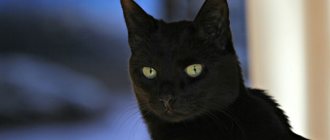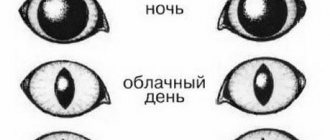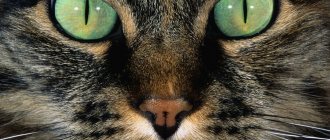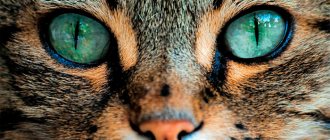Home » Useful Information
From time immemorial, the bewitching look of a cat has been surrounded by numerous beliefs and mystical speculations. Cats are even credited with the ability to see the other world and its inhabitants. To date, not all features of cat vision have been studied by scientists. But some information about how cats see has already been received and confirmed by experts.
- 2 How many colors can cats distinguish?
- 3 How far can he see?
- 4 How they see in the dark
- 5 What is the connection with the other world?
- 6 How they see our world
6.1 Do they see the image on TV and their reflection in the mirror?
- 6.2 How cats see humans
- 7.1 What to do if your cat begins to see poorly
Features of cat vision
The cat's organ of vision differs sharply from the human one in structure and ability to perceive space. They have large, round eyes with a convex lens. The viewing angle of space is 270 degrees.
A special feature of cats is stereoscopic vision. Each eye receives its own image of an object, which is then combined by the brain into one three-dimensional picture. As a result, the predator receives accurate information about the location of the prey and the distance to it.
Everything that the left eye sees goes to the right side of the brain and, conversely, the right eye transmits the picture to the left half
The genetic memory of a predator makes animals react to moving objects. Stationary animals are practically of no interest to them. Watching a moving object, the animal begins to actively move its head up and down: this is how the cat changes its viewing angle and focuses on the prey. This natural ability helps the predator calculate the distance to the prey down to the millimeter, which is why the cat’s jump is so accurate.
The special sensitivity of a cat's eyes is directly related to the structure of the pupil. It is located vertically and has increased elasticity. In bright light, it narrows, limiting rays from reaching the retina. Lack of lighting causes the pupil to dilate greatly, allowing more light to enter.
The sensitivity of a cat's eye is 6–8 times greater than that of a human. The reason for this is a special layer behind the retina called tapetum. It is a shell of vessels that look like mother of pearl.
Differences from humans
There are many such differences, and first of all this is the form. Due to the deep seating of the eyes, they do not differ in mobility; in order to cover objects located to the side with vision, the cat needs to turn its head. However, their visual angle reaches 270 degrees, which is much greater than that of a human.
Main differences from humans:
- viewing angles. For us - 160-180 degrees, for cats - 185-270 degrees;
- ratio of rods and cones. For humans it is 4:1, for cats it is 25:1, and this is the answer to the question of whether cats see in complete darkness. In this matter they are superior to man;
- visual acuity is 7 times higher than that of humans;
- the presence of tapetum, this is a special layer that reflects light;
- the ability to change the shape of the pupil;
- Felines are able to distinguish only 6 colors and 26 shades; they see shades of gray best. People distinguish up to 150 shades;
- pets have difficulty seeing objects located nearby, as well as stationary objects. But they see well what moves, and this allows them to hunt excellently.
How many colors can cats distinguish?
Until recently, there was an opinion that cats do not distinguish colors. It was assumed that all objects looked gray to them, similar in shades to mice. The main argument for this was that cats simply do not need color vision, because they hunt at night.
Recent research by scientists has refuted this claim. It has been proven that cats cannot distinguish only a few shades: orange, brown, red, green. Their eyes can see blue, violet, gray, and yellow colors. This perception is based on an increased number of cones in the eye, which decipher blue and green colors. There are practically no cones sensitive to shades of red in the eyes of these animals. Therefore, red colors are not available to cats.
Basically, the world from a cat's point of view looks bluish-gray, since they perceive purple and yellow colors less well.
There is no bright picture before the cat’s eyes, but her world is by no means gray
Instead of an afterword
While searching for information for this publication, I found one video that is only indirectly related to our topic today, but nevertheless, I would really like to know your opinion about the common myth that cats have the ability to see what we see. not available.
The fact is that I used to have a cat at home, which also behaved a little strangely several times. One evening she was sleeping on the sofa, but suddenly she suddenly jumped up, ran to the corner, lifted her head up and really started hissing at the top corner! The cat lived with us for about a year, during which time this happened twice. The most interesting thing is that the neighbor’s cat, who sometimes visited us, once behaved in a similar way and still with the same “angle”.
Perhaps this is just a coincidence? Or were the neighbors upstairs rolling balls on the floor that I didn’t hear? In any case, I did not see any other anomalies in the apartment! 
Have you ever had similar cases? Or do you have anything to add? Tell us about it in the comments! I'll really be interested in reading it!
How far can he see
The maximum distance at which a cat can clearly see objects is 60 meters, but to him an image at such a distance looks like a solid blur. The range of vision is limited to a distance of 20 meters. Scientists explain this feature by the fact that the predator hunts from an ambush, and there is no need to distinguish distant objects.
At too close a distance, cats also do not perceive what is in front of their eyes. An object brought closer to the muzzle than 50 cm is recognized by the animal’s senses of touch. This feature should be kept in mind when playing with your pet.
Domestic predators most clearly see objects located at a distance of 75 cm to 6 m. They need this value to calculate the height and length of the jump for prey.
How they see in the dark
The idea that cats navigate in pitch darkness is a myth. The animal sees in minimal light. A cat only needs 10% of the lighting that a human needs. People cannot see anything in such illumination. But this animal is a predator, so its eyes are equipped with additional receptors that have increased sensitivity to light. The tapetum on the back wall of the retina, like a mirror, reflects light twice, which is why cats' eyes glow so much in the dark. In fact, the eyes do not glow, but reflect the rays that hit them.
Cats look at us with multi-colored eyes. Colors like yellow amber, blue sea, blue sky, green grass or bright gold
Good orientation in the space of a dark room is explained by the fact that vision is not the only organ with which cats perceive the world. The secret of the animal is in the especially sensitive organs of touch - vibrissae.
Vibrissae (whiskers) are unique sensors that send information about surrounding objects to the cat’s brain.
Night vision at the DNA level
The characteristics of a cat's pupil are, of course, encoded at the genotype level. How does this happen? The retina of the eye contains specific cells that are sensitive to light - cones and rods. Cones provide contrast and clear vision, and rods are responsible for vision in low light.
The human eye is equipped with rods, but they are characterized by a diffuse or scattered arrangement, which is why twilight vision is called peripheral, not primary. A cat's rods are arranged in a special way; due to the formation of lenses, a cat's visual acuity is 10 times greater than that of a human. For this reason, when understanding with an animal, you can easily ask him: “Come and look.” Since cats are very smart, they will probably understand your request and even try to explain what they saw. The only thing is that they won't be able to do it during the day.
It is worth making a note that this only applies to night vision; during the day, they distinguish details much worse and most often sleep. Cats are nocturnal predators that have adapted to life with humans.
What is the connection with the other world?
Cats often observe objects that are not visible to humans. They suddenly jump up and start running around the room, knocking them over. At such moments, the animal’s pupils are dilated and its fur stands up. This behavior makes one believe that the cat sees the other world and its inhabitants. His gaze is accessible to what a person is unable to see.
When an animal looks into emptiness or, turning its head, examines an empty wall, there is no reason to worry. This is explained by the fact that even the quietest sounds that are alarming are accessible to a cat’s hearing. They do not come from the other world, but, quite possibly, from under the baseboard. The grandmothers’ assertion that at such moments the domestic predator communicates with the brownie is also from the realm of half-fairy tales.
Over the centuries, cats have been the source of scary stories thanks to their ability to see in the dark.
But the cat’s connection with a world unknown to man still exists. If your pet begins to behave restlessly, for no apparent reason, it is advisable to consecrate the home. Esotericists claim that a cat, having noticed an otherworldly body on its territory, tries to protect its owner from it. First, the animal freezes, trying to assess the “alien”’s intentions. If the cat thinks that the uninvited guest is dangerous for the owner, she tries to force him out with her own energy. When the danger is too strong and the cat cannot cope with it, it may even leave the house. It is not uncommon for cats to return as unexpectedly as they left. So the pet removes evil spirits from the home, and after getting rid of it outside the walls of the house, it returns.
Scientists do not see anything mystical in this behavior of cats and claim that any behavior of a cat is explained by its increased sensitivity to sounds and smells.
But no evidence has been presented to refute the ability of cats to see the inhabitants of the other world, so you can still believe in the supernatural power of a cat’s vision.
Why are they active at night?
The reason your pets are more active at night is because of the lifestyle of their ancestors. In ancient times, wild cats hunted at dusk. At this time, the heat had subsided and it was still light enough to see, pursue and catch prey.
The twilight hours gave cats the advantage of not being noticed by predators, who were more active in daylight and in the darkness of night.
And during the day there was enough time to rest and recuperate.
How they see our world
To see our world through the eyes of a cat, you need to look at a faded, blurry photograph. Nature has provided for the ability of predators to clearly see moving prey without paying attention to small details. A cat's eyes do not provide a complete picture of the world, so their vision is supplemented by other senses.
Cats see immediately with their eyes, nose and vibrissae - sensitive organs located on the face and tail. It is much more important for them to touch and smell an object than to just see it.
Do they see the image on TV and their reflection in the mirror?
Scientists are divided on the perception of images on a TV screen. Some argue that animals see flickering and movement of objects. To confirm this, many owners testify that their pets love watching animals on the screen, and after switching the channel they immediately lose interest in the TV.
Cats not only love to watch TV, but also sleep on it.
Others are sure that TV programs in the eyes of animals look like static pictures replacing each other. They explain this fact by the fact that cat's eyes perceive images at a speed of 40 frames per second. In this case, the TV is configured for human perception, that is, 24 frames. For an animal to see movement on the screen, the frame must be updated 50 times per second.
In the mirror, the cat sees itself normally, but begins to hiss and flatten its ears. This behavior indicates fear. The image without odor and auditory vibrations is incomprehensible and causes fear.
How cats see humans
Pets see people as they are. They adequately assess height, recognize movements and voice. But animals see a clear picture only at a distance of 0.5 to 5 meters. At a distance of 7–10 meters, the pet sees only a silhouette and can recognize the owner by smell and voice.
There is an opinion that, in addition to the physical body of a person, cats can see his biofield. This ability can explain different attitudes towards strangers. The animal approaches some without fear, allows itself to be petted, and even goes into your arms. He doesn't let some strangers come close to him. The animal evaluates a person's aura and accurately determines who may pose a danger to him.
The ability to see the aura is reflected in the cat’s ability to identify a sore spot on the owner’s body. The pet draws out the negative energy of the owner, thereby having a beneficial effect on his health.
If a cat living in a house is constantly sick and no treatment helps, the owners should think about their own health.
By the way a domestic predator looks at a person, you can understand what his mood is at the moment and guess his desires:
- peace and tranquility is expressed by squinting eyes and constricted pupils;
- fear is reflected in wide open eyes and maximally dilated pupils;
- when the pet intends to beg the owner for a treat, the gaze becomes intent, straight into the person’s eyes;
- if an animal, without looking away, looks at a person, periodically slowly closing its eyes, it expresses its love.
Vision problems: how to notice them
Cats suffer from various vision disorders quite often. The owner should be wary if the animal hides its eyes from bright light or often rubs its face with its paws. Signs of inflammation are frequent blinking of the pet, pus in the corners of the eyes, clouding of the whites, swelling of the eyelids. Any of these signs is a reason to immediately consult a veterinarian.
Kittens that are blind at an early age have much longer whiskers than their kittens. This is how nature compensates for the lack of visual perception of the world
Some eye diseases can cause complete blindness in your pet. It is difficult to notice vision problems in cats in order to take timely measures, since they are able to navigate in space even with complete blindness. The following signs indicate that vision problems have begun and should be checked:
- the animal does not jump to its favorite places located at a height or, when jumping, misses and falls;
- when moving around the house, he comes across moved or new furniture, objects standing in unusual places;
- your pet’s pupils do not constrict in bright light;
- stops responding to favorite toys;
- when the pet looks at the owner, his gaze does not focus on him.
All these signs indicate a deterioration in the cat’s vision or the onset of blindness.
What to do if your cat begins to see poorly
Unfortunately, it is not always possible to restore a pet’s vision, but this is not a reason to abandon a sick animal. The owner should organize the space of the home in such a way that the animal feels comfortable. Your pet can live a full life if you do the following:
- do not change the location of bowls with food and water;
- do not let the animal out into the street unattended, take it for a walk on a leash;
- in a new room, accustom the cat to the location of objects, without frightening them and allowing them to find their own way;
- do not block the path with boxes, scattered toys and other objects.











